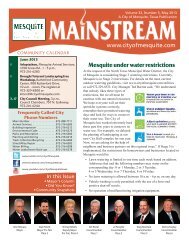airport/documents/Mesquite Master Plan Final.pdf - The City of ...
airport/documents/Mesquite Master Plan Final.pdf - The City of ...
airport/documents/Mesquite Master Plan Final.pdf - The City of ...
You also want an ePaper? Increase the reach of your titles
YUMPU automatically turns print PDFs into web optimized ePapers that Google loves.
eight miles to the east is V15 and 11<br />
miles to the west is V369.<br />
Instrument Approach Procedures<br />
When the visibility and cloud ceilings<br />
deteriorate to a point where visual<br />
flight can no longer be conducted safely,<br />
aircraft must follow published<br />
instrument approach procedures to<br />
locate and land at the <strong>airport</strong>. <strong>The</strong>re<br />
are currently three published<br />
instrument approach procedures to the<br />
<strong>Mesquite</strong> Metro Airport: ILS Runway<br />
17, NDB or GPS Runway 17, and<br />
Localizer Back Course Runway 35.<br />
<strong>The</strong> Runway 17 ILS approach provides<br />
the <strong>airport</strong> with the lowest approach<br />
visibility minimums. Utilizing this<br />
approach, a properly equipped aircraft<br />
and pilot can land at the <strong>airport</strong> with<br />
250-foot cloud ceilings and threequarters<br />
<strong>of</strong> a mile visibility. <strong>The</strong> ILS<br />
Runway 17 approach can also be<br />
utilized as a localizer only, or circling<br />
approach. A circling approach allows<br />
the approach to be flown to the opposite<br />
runway end (i.e., the ILS Runway 17<br />
circling approach would be utilized to<br />
land on Runway 35).<br />
Runway 17 is also served by a NDB or<br />
GPS approach. Using the previously<br />
mentioned <strong>Mesquite</strong> NDB or GPS<br />
navigational aids, instrument<br />
approaches for aircraft with approach<br />
speeds less than 121 knots landing on<br />
Runway 17 can be made when the<br />
visibility is at least one mile and the<br />
cloud ceilings are greater than 473 feet<br />
AGL. For aircraft with approach speeds<br />
<strong>of</strong> 121 knots but less than 141 knots,<br />
approaches to Runway 17 can be made<br />
1-16<br />
with 473 foot cloud ceilings and one and<br />
one-quarter mile visibility. This<br />
approach procedure also provides for<br />
circling approaches to Runway 35.<br />
Runway 35 is served by one published<br />
instrument approach. <strong>The</strong> Localizer<br />
Back Course Runway 35 approach<br />
utilizes the <strong>airport</strong>’s localizer for<br />
straight-in approaches from the south<br />
and circling approaches to Runway 17.<br />
<strong>The</strong> localizer emits signals in both<br />
directions. In conducting a back-course<br />
approach, the pilot must adjust to the<br />
opposite signals provided by the<br />
localizer. Details <strong>of</strong> the published<br />
instrument approaches are provided in<br />
Table 1E.<br />
Arrival and Departure Procedures<br />
Due to the congested airspace over the<br />
Dallas/Fort Worth Metroplex, the FAA<br />
has established a series <strong>of</strong> Standard<br />
Terminal Arrival (STAR) and Departure<br />
Procedures (DP). <strong>The</strong> STAR is a preplanned<br />
air traffic control arrival<br />
procedure designed to provide for the<br />
transition from the enroute phase <strong>of</strong> the<br />
flight to an outer fix or an instrument<br />
approach fix in the terminal area. <strong>The</strong><br />
four published STARs are: Dumpy Two,<br />
Fingr Three, Gregs Five, and Knead<br />
Five.<br />
<strong>The</strong> DP is a preplanned air traffic<br />
control departure procedure that<br />
provides for the transition from the<br />
terminal area to the enroute phase <strong>of</strong><br />
the flight. <strong>The</strong> seven published DPs<br />
are: Dallas Seven, Garland One,<br />
Hubbard Five, Joe Pool Nine, Kingdom<br />
Five, Texoma Seven, and Worth Three.




